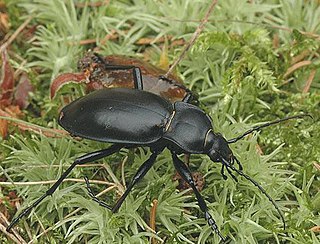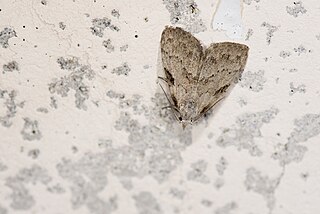Rhomborhina is a genus of large scarab beetles described by Hope in 1837. They are members of the subfamily Cetoniinae. They mostly live in East and South Asia. The name is frequently misspelled as Rhomborrhina following an unjustified change by Hermann Burmeister in 1842.

Flower chafers are a group of scarab beetles, comprising the subfamily Cetoniinae. Many species are diurnal and visit flowers for pollen and nectar, or to browse on the petals. Some species also feed on fruit. The group is also called fruit and flower chafers, flower beetles and flower scarabs. There are around 4,000 species, many of them still undescribed.

Carabus is a genus of beetles in family Carabidae. The genus is highly diverse with 91 subgenera and more than 1000 recognised species, thus is the largest genus in the subfamily Carabinae. The vast majority are native to the Palearctic, but 11 Nearctic species are also known. Carabus spp. are 12–50 mm (0.47–1.97 in) long, and most species are wingless and often very colourful. These are nocturnal, predatory beetles that feed on snails, earthworms, and caterpillars.

Pterostichus is a very large genus of ground beetles with a Holarctic distribution in the subfamily Harpalinae. It has over 1,100 species. The beetles are predatory, but sometimes feed on strawberries. They can be found under rocks and prefer slightly moist, sandy soil although preferences differ between species. Pterostichus contains the following species:

Manoba is a genus of moths in the family Nolidae. The genus was first described by Francis Walker in 1863.

Onthophagus is a genus of dung beetles in the Onthophagini tribe of the wider scarab beetle family, Scarabaeidae. It is the most species-rich and widespread genus in the subfamily Scarabaeinae, with a global distribution.

Polyphylla is a genus of scarab beetle includes more than 80 species distributed in North and Central America, southern and central Europe, northern Africa, and southern Asia—from Asia Minor to Japan. They typically reside in forests and orchards with most being identified by white elytra scales forming stripes. The adult beetles are often attracted to lights. Polyphylla lay their eggs on soil near plants from where the larvae hatch and burrow down to the roots on which they will feed. They reach maturity in two to three years.

Euselates is a genus of beetle belonging to the family Scarabaeidae.

Liatongus is a genus of dung beetles in the subfamily Scarabaeinae of the scarab beetle family. At least part of the upper surfaces are without hairs; the head and pronotal disc are generally sculptured; and the genae are rounded, with little or no indentation between the clypeus and the genae. Length ranges from 7.4 to 10.9 mm. Colours vary: they may be uniform brown or dull purple, or have red, white or yellow patterns on the elytra.

Cetoniini is a tribe of fruit and flower chafers in the family of beetles known as Scarabaeidae. There are over 80 genera in Cetoniini.

Phyllopertha is a genus of shining leaf chafers in the beetle family Scarabaeidae. There are more than 20 described species in Phyllopertha, found primarily in the Palearctic.

Tropinota is a genus of fruit and flower chafers in the beetle family Scarabaeidae. There are about 14 described species in Tropinota.
Brahmina is a large Holarctic genus of scarab beetles in the tribe Melolonthini, containing over 90 species in three subgenera.











